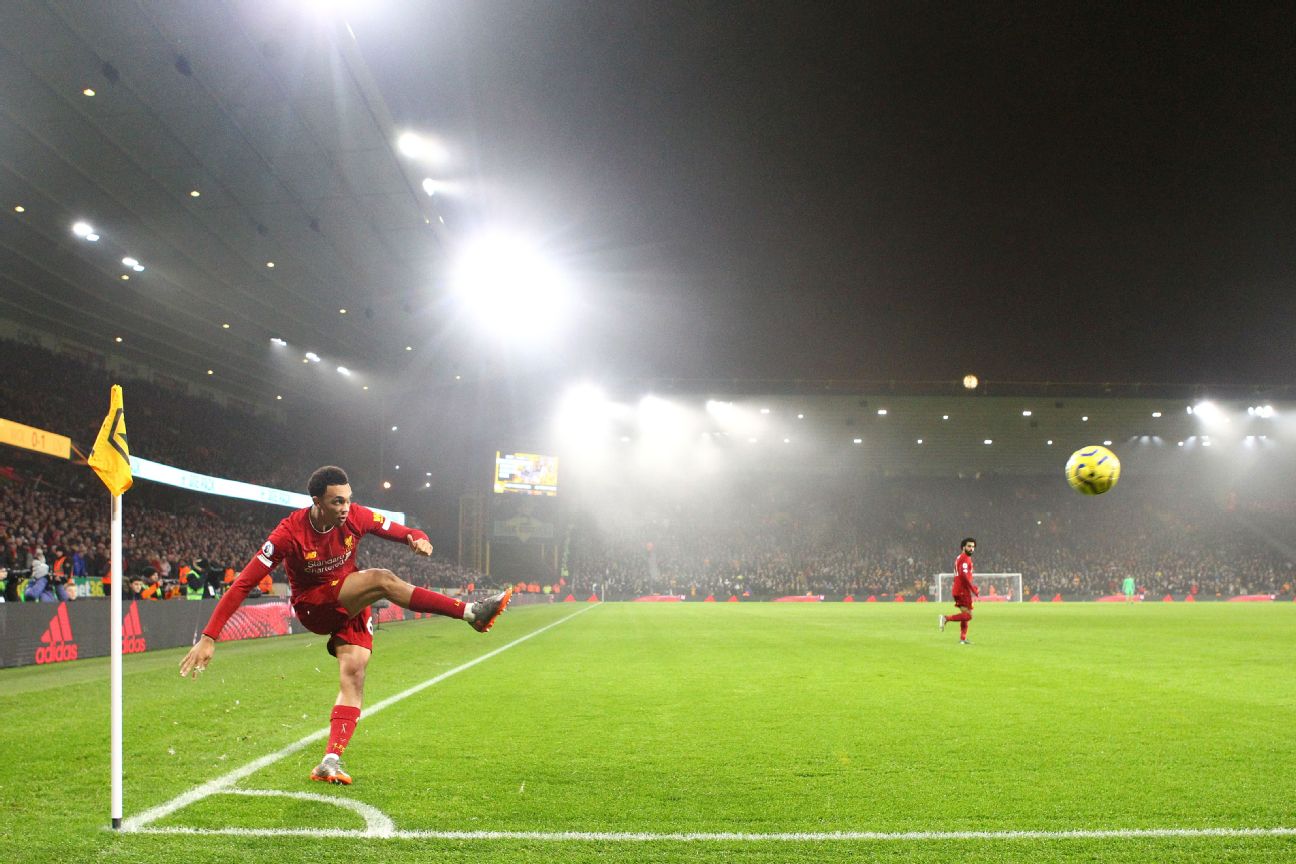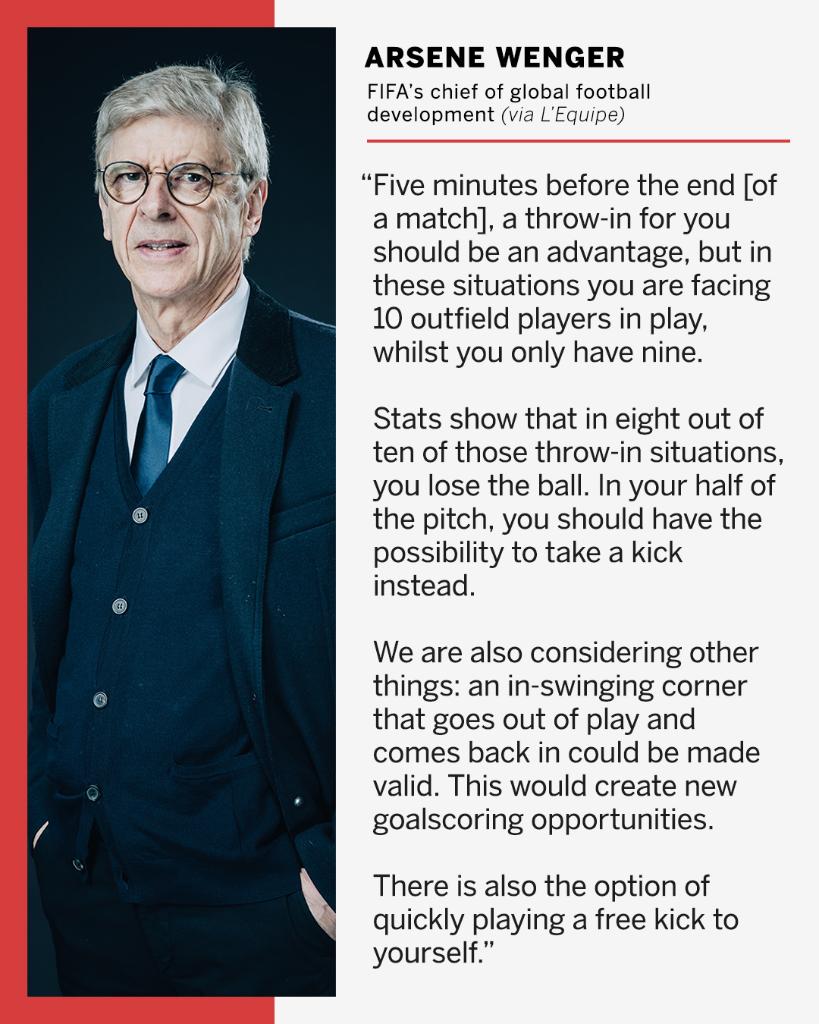In his role as FIFA’s Chief of Football Development, former Arsenal manager Arsene Wenger is one of the key figures charged with overseeing the process of adapting and improving the laws of the game.
Over the past few months, the 70-year-old has been busy drafting up a series of tweaks and changes — some more radical than others — that he thinks will transform football for the better.
First and foremost, Wenger would like to overhaul the offside rule, though he has also suggested wholesale changes to throw-ins and corners.
Explaining his vision to L’Equipe this past week, the Frenchman offered a list of the alterations he’d like to make to the current rule book.
Here’s a point-by-point breakdown of Wenger’s ideas, plus a few more he might like to consider.
– ESPN+ viewer’s guide: Bundesliga, Serie A, MLS, FA Cup and more
– Insider Notebook: Man United transfers special
Flipping the offside rule
“For the moment, you are offside if a part of your body that you can score with sits ahead of the body of a defender. I would like it to be that there is no offside so long as a [single] body part which a player can score with is in line with the defender. This could be too much of an advantage for an attacker, because that obliges the defenders to play higher up.”
The fundamental change Wenger would like to make to the offside rule would give attacking players much more leeway when attempting to dart behind the defensive line or snap up chances in a crowded penalty area.
– Johnson: How VAR has changed in Premier League for 2020-21
– How VAR decisions have affected every Prem club this season
It would mean that if any part of the attacker’s body (with which they can legally play the ball) was level with the last defender, the attacker would be considered onside — basically the polar opposite of the current, overly fastidious iteration of the rule.
For example, if an attacker scores with the majority of their body in an offside position but a stray toe or shoulder is found to be level with the last defender, the attacker would be considered onside and the goal would be perfectly legal.
Of course, long before VAR started flagging nano-slivers of toes and armpits, the offside law was originally implemented as a simple measure to prevent forwards from goal-hanging for 90 minutes.
If they were really serious about it, FIFA would simply prohibit all attacking players from entering the opposing 18-yard box at any point which would therefore force all goals to become long-range rockets into the very top corner.
Replacing throw-ins with kick-ins
2:19
Liverpool’s throw-in coach Thomas Grønnemark insists teams still undervalue the importance of throw-ins.
“I would also like to change the throw-in rule: five minutes before the end, a throw-in for you should be an advantage, but in these situations you are facing 10 outfield players in play, whilst you only have nine. Stats show that in eight out of 10 of those throw-in situations, you lose the ball. In your half of the pitch, you should have the possibility to take a kick instead.”
After crunching the numbers and noting that attacking teams generally find little to no advantage from taking traditional throw-ins during the latter stages of matches, Wenger proposed a radical notion of allowing attacking teams to take rush “kick-ins” instead.
Allowing attacking teams to get the ball in motion quickly would negate the perceived numerical disadvantage they face in having a man leave the field, however briefly, in order to take a throw-in.
It means attacking teams could restart play almost immediately or choose to launch a long-ball from the touchline deep into enemy territory should they be chasing a late goal.
Of course, this “Hail Mary” could be easily countered by crafty defenders putting their body or face on the line and simply standing directly in front of the kick-in taker — but that’s a matter for the likes of Sean Dyche to contend with.
Rory Delap’s long throw became a thing of legend during @stokecity‘s debut #PL season 🔴⚪️#PLMoment pic.twitter.com/nedTbKq4sL
— Premier League (@premierleague) April 25, 2017
It’s possible that kick-ins would help facilitate a more open, flowing game in the final stages of matches but it’s also possible that they would create less transition, fewer counter-attacks and fewer breakaway goals.
After all, is there not a simple joy in watching a player absolutely launch a long throw into the mixer like a medieval trebouchet and revelling in the chaos that ensues? After all, the Premier League hasn’t been the same without Rory Delap.
Plus, with throw-ins a thing of the past, throw-in coach extraordinaire Thomas Gronnemark would be out of a job. What would Liverpool do then?
– Hamilton: Meet Thomas Grønnemark — Liverpool’s secret weapon
– O’Hanlon: How Delap’s long throw-ins ruffled Wenger’s parka
Truly out-swinging corners

“We are also considering other things: a corner that goes out of play and comes back in could be made valid, this would create new goal-scoring opportunities.”
Wenger seems to want the hard boundaries of a football pitch — enshrined in the original laws of the game and sacrosanct for over 150 years — to become temporarily permeable for players unable to keep a corner kick in play.
Just do corners better, would be our advice here.
Or, if players can no longer be trusted to keep their set pieces in play, might we suggest that mechanical ball cannons are brought into play? Placing one in each corner of the pitch would result in the perfect arcing trajectory for every single corner, and the goal line would remain the undeniable edge of the field.
DIY free kicks
“There is also the option of quickly playing a free kick to yourself.”
No more detail was offered but Wenger dangled the carrot of players being able to restart play quickly by taking a free-kick to themselves.
Currently, after a free kick is taken, the taker isn’t allowed to touch the ball again until somebody else has, be it a teammate or an opponent.
Wenger’s tweak would see players presumably allowed to dribble a ball straight from a free kick, similar to a tap kick in rugby. This would speed up restarts and open up a brave new world of elaborate, convoluted and ridiculous set pieces — of which we’re entirely in favour.

